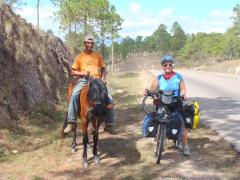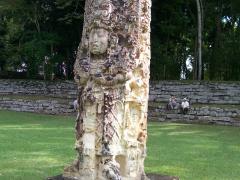Blogs
Impressions of Nicaragua
What a delightful surprise Nicaragua has been to ride in. From the moment we crossed the border from Honduras into Nicaragua, biking through a country which is the poorest in Central America has been a great experience. Yes we see some very sad sights, houses made of mostly discarded scraps of plastic, lumber, tin and natural products, children without shoes, communities with no electricity, shared wells and old people begging for money. But mostly we find a land with a many different aspects.
We ride up through dry mountain regions on remote dirt roads and everyone tells us we will have no troubles, that we´ll have no security problems because we are outside the urban areas. What we have found is whole communities come out to see the Gringos on bikes riding through their neighborhood, children yelling out hello, good afternoon or by practicing the few words of English they know. Many children near the border would ask for money, the only word they knew. Randy gave a few of the children in Honduras a lecture about asking for money and how it was impolite not to say hello as a friend, but none of the children in Nicaragua have been like that. We learn a lot as we ride through the different parts of Central America.
Some of the steep mountain areas cause us to rest more and to walk our bikes up the steep grades. We have had a chance to walk with more people or ride along a campesino on a horse. read more here... lee mas aquí... »
Crossed into Nicaragua today
We crossed into Nicaragua today - our 6th country on the trip. We had no problems at all, and all the officials were very friendly. Once again, we even got a fair rate of exchange from the moneychanger. We now have Nicaraguan Córdobas, which about about 18 to the dollar, instead of Honduran Lempiras, which are about 19 to the dollar.
Route through Honduras
You may remember our friend Tim Malloch that we met in the north of Mexico, in the Copper Canyon region. He was headed north, and we south, and like all travelers we meet, we pestered him with lots of questions about his route and his favorite places along it. We remembered him telling us that the back roads from Santa Rosa de Copan to La Esperanza were his favorite section in all of Central America. So we set out to follow his route. We suspected, but didn't know, that it would continue the really tough mountainous route that we'd already been struggling with in Guatemala. But we took it, and he was right, it was delightful. We spent several days with nearly no traffic, delightful pine-covered hills, and interesting people tucked back in remote valleys. We passed by little roof-tile making operations (apparently the clay is good in this area) and climbed through some of the most remote areas we've been in since northern Mexico. In one town we found no available hotel or "hospedaje" (cheap hospitality) but the mayor happily opened up the municipal offices and settled us in the community meeting room. We had all the comforts of life including a bathroom and a cold shower (which was one of the lesser cold showers we've had). read more here... lee mas aquí... »
Banking in Honduras
People often ask us how we get money for our daily travels. For the last year and one half we have been able to get money from an ATM using a debit card. While there is not one in every town through out Central America we have been able to plan ahead and get enough money for a week or two or more of travel. Sometimes I feel awkward because I can just go into one of the ATM booths, bypassing the long lines waiting to go into the bank. I just go into one of the private booths, slip my plastic card into a machine and get a couple hundred dollars worth if the local currency.
This is how we have been able get our money until we reached. Gracias, Honduras. We miscalculated our available Lempiras, the Honduran currency, partly due to a hotel clerk in Copan Ruinas going through our bags as we explored the area and removing a few things from our bag including our stashed reserve. We we did not notice the cash being gone until we got low on money. So of course we go looking for an ATM which turned out to be non-existent in the town of Gracias. I went to all three banks to see if I could use my debit card as a Visa and with draw money. It turned out I could at one bank but the system was down and I needed to come back two hours later. I was curious to see I could use my debit card at another bank and since I had a couple of hours to wait anyway I gave it a shot.
What I found at the other bank which is true of all the banks is there is always one or two uniformed guards standing at the entrance with guns that look like sawed-off shotguns. read more here... lee mas aquí... »
Copan Ruins in Honduras
Our first stop in Honduras (and one of the reasons we chose the route we did) was the famous Mayan ruins of Copan. We dragged in at the end of another 3-day stretch of riding these mountains (about the best we've been able to do before resting at least a day). Nancy was sick with some kind of stomach thing and we were both finishing off colds. (All of these ailments are long gone now, thankfully.)
So we weren't at our best the next morning when we went to the ruins. We spent the entire morning there, and hired an English-language guide to explain it all. But we were all the time just feeling like we wanted to be in bed or getting something to eat, which is not what you want when you're at one of the world's most famous and important archaeological sites.
Despite our sorry state, we really appreciated the artistic beauty of the place. We've been to several other Meso-American ruins, and the beauty of the stelae (tall stones that tell a story) and other engravings was just off the chart. Somehow they really developed a much more artistic way of doing all the hieroglyphic writing here.
The environs are beautiful green luxuriant growth, like at Palenque, but the structures are considerably smaller.
Probably the most significant thing we've taken away from Copan was the enormous connectedness of the ancient Mesoamerican world. read more here... lee mas aquí... »
La Tigra National Park Cloud Forest
In Central America there is still some remaining cloud forest. In Honduras we had a chance to visit Parque Nacional ¨La Tigra¨ for a couple of days. We took a 3 hour hike up into the high mountains. We walked along the flower lined path up further into the heavens and into the misty rain forest. The thickness of the clouds increased with each meter we climbed. The visibility dropped down to nearly nothing and the silence of the jungle like mountain forest became louder. Up at 1800 meters there are pine trees, flowering hard wood trees, mosses engulf everything. The parasitic bromeliads grow in the branches and grow with vengeance. We climbed to the 100 meter waterfall before calling it quits. We could have climbed another 6 hours but that day was suppose to be a rest day. It was wonderful having the whole rainforest to ourselves, we did not see another person hiking the old mining trails of ¨La Tigra National Park¨.
What was amazing is that we where only 15 Kilometers from Tugucigalpa, the capital of Honduras. It was just over the ridge another couple of thousand meters higher and then down a couple thousand more. read more here... lee mas aquí... »
Coffee Harvest
The areas we've been riding through on Guatemala and Honduras are all full-bore into the coffee harvest. Coffee is everywhere, and it's really interesting to see where that brew comes from.
On the picking side, we've met little kids with mayonaise jars and whole families, each with a home-made bucket. They work as hired hands, getting paid about 1 lempira, or 2 cents per pound of picked coffee. A family can pick a fair bit in a day - maybe each of the kids can pick 40 pounds, bringing in US$2.00. This time of the harvest can be the primary cash earning time of many of these campesino families.
We met Carlos, on the complete upper end of the coffee spectrum, at a hot spring in Gracias, Lempira, Honduras. He is a coffee taster, employed by the Guatemalan national coffee testing laboratory, and he helped us understand some of the details about the harvest. He mentioned that US people have a tendency to disapprove of small children being involved in the coffe harvest, but here it's a longstanding tradition, and beneficial to the families. Carlos also explained what makes coffee good (bigger beans, shade grown, mountains, etc.) and what the various grades of coffee are, and how world price fluctuations affect this region (a lot!)The coffee bean off the bush is a largish green thing, which has to have the outer fleshy part ripped off with a machine to leave the inner bean. This step of the harvest is invariably done with a machine. Then the coffee is left out in the sun for three days to dry. read more here... lee mas aquí... »
Guatemala Reprise: New Pictures and Route Update
Here is a slideshow of the pictures from the last week or two in Guatemala (plus the Copan Ruins in Honduras). You can view all the pictures in full size and with their captions on flickr.








